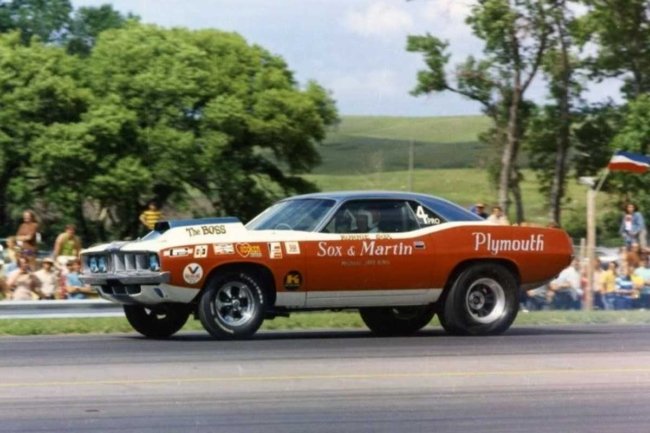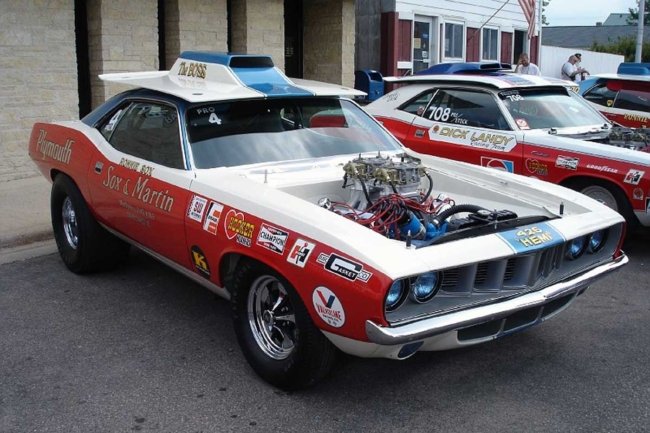
The team of Sox & Martin was a legendary duo in drag racing during the 1960s and 1970s. They were widely known for their dominance in the Super Stock and later the Pro Stock classes of the National Hot Rod Association (NHRA), International Hot Rod Association (IHRA), and American Hot Rod Association (AHRA) sanctioning bodies.
Above Left: Sox & Martin had a storybook year in 1971 with their ’71 Hemi ‘Cuda. The team won almost every event they entered. The team was formidable, with Martin overseeing and working with the sponsors, King fine-tuning the Hemis, and Sox at the wheel. Above Right: ‘The Boss’ Hemi ‘Cuda sported a Weiand tunnel ram to achieve the edge needed to win. (Photographers Unknown)
The team consisted of Ronnie Sox, the driver famous for his unparalleled ability to shift manual transmissions with incredible speed and precision. Known as “Mr. Four-Speed,” Sox was a racing prodigy who excelled at extracting peak performance from the Sox & Martin Plymouths.
Buddy Martin, the team manager and strategist, was the mastermind behind the operations. His meticulous planning ensured the team’s cars were always prepared to perfection, and he constantly pushed the boundaries of innovation, keeping Sox & Martin at the forefront of the racing world.

Above: With Chrysler’s backing, Sox & Martin were substantially ahead of the competition in 1971. With the help of several team members, Dave Christie transformed the “body-in-white” ‘Cuda into the most feared Pro Stocker of the era. (Photographer Unknown)
Jake King was the team’s lead mechanic. He was recruited by the team in 1964, and with his high mechanical aptitude, he quickly adapted to the new Hemi after years of working on Ford engines. King tuned engines and drove race cars before joining the team, but his true passion was building high-horsepower engines and applying new technology and innovations to each engine he built.

Above: Long before using sheet metal tunnel ram intakes on Pro Stock engines, Sox & Martin relied on the proven manifolds from Weiand. Also, you may be cool, but are you so cool that you get your name embossed on a Firestone tire? (Photo – Car Craft magazine – September 1971)
The Sox & Martin Plymouths were all adorned with the team’s signature red, white, and blue paint scheme. The colors were often scene in the winner’s circle during the team’s dominance of the formative years (1970 – 1972) of the Pro Stock eliminator.
During those years, the Pro Stock vehicles were built from a “body-in-white” chassis, a term used to describe a vehicle’s body shell before the addition of any components or systems. Dave Christie, the team’s chassis builder and tuner, handled the chores of transforming the chassis into a competitive vehicle at the Sox & Martin race shop in Burlington, North Carolina. This approach allowed for a more customized and optimized design, giving the team a competitive edge.

Above: The Weiand tunnel ram on the King blue-colored Hemi appears stock from the outside. However, to flow the air necessary to feed the hungry Hemi, the Weiand manifold and the Holley 4500s are significantly modified. (Photo – Mecum Auctions)
Sox & Martin’s 1971 Pro Stock HEMI ‘Cuda was an engineering marvel, leading the field with its technical advancements. The team’s use of titanium and other exotic lightweight materials, a redesigned hood scoop to increase proficiency, and a modified rear suspension with a ladder bar design highlighted their pioneering spirit and fascination with innovation.
In 1971, well before the era of handmade sheet metal intake manifolds, Sox & Martin relied on castings from Weiand. The cast dual four-barrel intakes were ported and modified with air dams to extract the maximum airflow.

Above: Jo-Han immortalized the famous Sox & Martin Hemi ‘Cuda in 1/25-scale plastic. Like the real car, the kit came “body-in-white” and required a talented model maker to emulate the red, white, and blue paint scheme.
As stated by Sox in the September 1971 edition of Car Craft magazine, “We are strictly not a one-shot team. That’s why ‘The Boss’ is Weiand-equipped…to keep us winning consistently.” This statement reflects the team’s commitment to using the best equipment to maintain their ways.
The reworked 426 HEMI wore a pair of tuned-to-the-max Holley 4500 carburetors on top of the Weiand manifold, utilized a pair of highly modified aluminum heads, a top-secret camshaft design, a compression ratio around 12.5:1, and a transistor-style ignition. At the 1971 season opener, the National Hot Rod Association (NHRA) Winternationals, Sox was the low qualifier with a 9.81 at 141.50 mph.

Above: Weiand offers a tunnel ram intake manifold for the Mopar big-block engines, including the Hemi. While it flows sufficient air for all but the most radical engines, it still does not flow the numbers that King was able to achieve.
Sox in the S&M 1971 ‘Cuda was the top eliminator, and unfortunately for the competition, the trend continued. The team would win all its match races and all but two NHRA events it entered that year.
Weiand (pronounced “Why-And”) is owned by Holley Performance Brands, which owns several other prominent brands in the performance and racing industry, such as MSD Ignition, Flowmaster, Hooker Headers, and NOS (Nitrous Oxide Systems).
Above Left: For the street, Weiand has a dual-plane manifold for the small-block Mopars, providing excellent low- and mid-range torque while maintaining great street manners. Above Right: For the small-block crowd that wants to spin the engine a little harder, a Weiand tunnel ram is the answer. The manifold is designed to provide the ultimate horsepower at a higher RPM.
Weiand is known for its high-performance intake manifolds, superchargers, and related components. Holley’s acquisition of Weiand allowed the brand to remain a staple in the performance aftermarket industry while benefiting from Holley’s extensive distribution network and resources.
Weiand intake manifolds are high-performance components used in internal combustion engines to improve airflow and increase horsepower. The manifolds are designed primarily for enthusiasts looking to enhance engine performance in cars, trucks, and racing vehicles. They are popular in the hot-rodding, drag-racing, and custom vehicle communities.

Above: Did you know Weiand is in the oil pan business? It has several oil pan options with the oil pickup tube and all the necessary mounting hardware.
Weiand single-plane manifolds optimize high RPM performance and are used in racing, while dual-plane manifolds offer a balance of low- and mid-RPM torque, which is ideal for street performance. The intake manifolds increase horsepower and torque by optimizing air and fuel mixture delivery to the engine, enhance throttle response and engine efficiency, and are suitable for the harshest of driving conditions.
Weiand intake manifolds are a favorite among car builders and are often part of engine comprehensive performance upgrades. For more information click over to Weiand or Holley for the latest in Mopar products.
Cover Photo – Mecum Auctions














